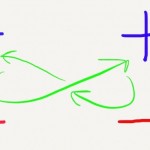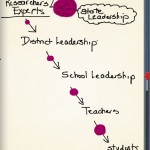“These changes you’re talking about – it’s not just reforming the union. We have to organize teachers all over again. The first time we organized their economic rights; now we have to organize them as educators. We have to organize the other half of their jobs.”
Those words characterize, almost, the nature of the NEA Western Regional Leadership Conference, the first NEA event I’ve attended since deciding to join in June.*
My first take away from the event, and I have no reference point, is that the union seems on the cusp of change. I helped as "synthesizer" in a couple of sessions. Synthesizers would capture interesting points made by participants and send them to graphic facilitator Taryl Hanson, who created a visual compilation of the thinking in the meetings.
And like I say, most of the thinking was around change and leading change and changing leaders and leadership. One representative comment I sent to Taryl was:
"I’m beginning to realize that my first response to a problem should be, 'What can I do?’ not, ‘What is the union going to do?'"
Beyond that, a major topic of discussion at the WRLC was The Teacher Leadership Initiative – a pilot program in which participants, who are teachers, develop and apply their teacher leadership skills. The TLI was created through a partnership of the NEA, The National Board of Professional Teaching Standards, and The Center for Teaching Quality, which demonstrates the commitment by the NEA to enable accomplished teachers to lead without leaving the classroom. (Disclosure – fully half my teacherpreneur work is related to the TLI.)
To add context and perspective to members, the keynote speaker at lunch Saturday was a Cornell professor who specialized in union evolution. He explained that a good strategy for change is to seat opponents on decision-making bodies so that their decisions have a wide spectrum of ownership. The focus was less on collaboration and more on minimizing the finger pointing that would accompany a bad decision. He used the old line that, "It's better to be inside the tent pissing out, than outside pissing in."
And that makes me think that I might be in the worst place of all – standing in the door getting it from both sides.
So let’s just deal with it. I’m a Right-leaning Independent, but most my colleagues in teacher leadership lean to the Left – a few so far I wonder how they keep from falling over. Yet, they actively recruited me into their networks. And goodness knows, they have provided, from their limited resources, the time, training, opportunity, and compensation by which I can pursue my teacher leader vision.
So, why did I use the qualifier “almost” in describing the nature of the WRLC as being one of organizing teachers as educators?
Because part of the nature of the WRLC is a remnant of the Manichean attitude that all who are in the tent are Good and all who are not are Bad.
I see that more in off hand, yet personal, portrayals of those who old opposing views. It was disheartening to hear an NEA leader comment to a small, but not intimate, group of teachers, many of whom he had just met, that the opposition was “sons of bitches.”
I also see the "us versus them" attitude in the boundaries of casual conversations. Here’s an example. A wise crack about the petty vindictiveness of a Republican governor’s staff who closes traffic lanes as political punishment is ok. But how well would a reference to a Democrat president’s pettiness in closing the World War II monument for political gain gone over? Maybe ok. I really don’t know but didn’t feel comfortable seeing for myself, at least with people I had just met.
But to the the lingering question of whether I should be in the union, my experience at the Western Regional Leadership Conference suggests that the answer is yes. A qualified yes.
____________________________
*They were spoken by an unidentified National Educational Association organizer to author Charles Taylor Kerchner and open United Mind Workers: Unions and Teaching in the Knowledge Society (coauthored with Julia F. Koppich and Joseph G. Weeres).








